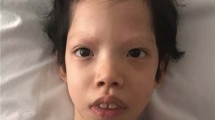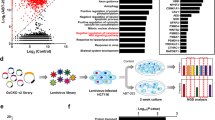Abstract
Noonan syndrome (NS) and cardio-facio-cutaneous syndrome (CFCS) are related developmental disorders caused by mutations in genes encoding various components of the RAS-MAPK signaling cascade. NS is associated with mutations in the genes PTPN11, SOS1, RAF1, or KRAS, whereas CFCS can be caused by mutations in BRAF, MEK1, MEK2, or KRAS. The NS phenotype is rarely accompanied by multiple giant cell lesions (MGCL) of the jaw (Noonan-like/MGCL syndrome (NL/MGCLS)). PTPN11 mutations are the only genetic abnormalities reported so far in some patients with NL/MGCLS and in one individual with LEOPARD syndrome and MGCL. In a cohort of 75 NS patients previously tested negative for mutations in PTPN11 and KRAS, we detected SOS1 mutations in 11 individuals, four of whom had MGCL. To explore further the relevance of aberrant RAS-MAPK signaling in syndromic MGCL, we analyzed the established genes causing CFCS in three subjects with MGCL associated with a phenotype fitting CFCS. Mutations in BRAF or MEK1 were identified in these patients. All mutations detected in these seven patients with syndromic MGCL had previously been described in NS or CFCS without apparent MGCL. This study demonstrates that MGCL may occur in NS and CFCS with various underlying genetic alterations and no obvious genotype–phenotype correlation. This suggests that dysregulation of the RAS-MAPK pathway represents the common and basic molecular event predisposing to giant cell lesion formation in patients with NS and CFCS rather than specific mutation effects.
Similar content being viewed by others
Log in or create a free account to read this content
Gain free access to this article, as well as selected content from this journal and more on nature.com
or
References
Noonan JA : Hypertelorism with Turner phenotype. A new syndrome with associated congenital heart disease. Am J Dis Child 1968; 116: 373–380.
Allanson JE : Noonan syndrome. J Med Genet 1987; 24: 9–13.
Tartaglia M, Mehler EL, Goldberg R et al: Mutations in PTPN11, encoding the protein tyrosine phosphatase SHP-2, cause Noonan syndrome. Nat Genet 2001; 29: 465–468.
Roberts AE, Araki T, Swanson KD et al: Germline gain-of-function mutations in SOS1 cause Noonan syndrome. Nat Genet 2007; 39: 70–74.
Tartaglia M, Pennacchio LA, Zhao C et al: Gain-of-function SOS1 mutations cause a distinctive form of Noonan syndrome. Nat Genet 2007; 39: 75–79.
Razzaque MA, Nishizawa T, Komoike Y et al: Germline gain-of-function mutations in RAF1 cause Noonan syndrome. Nat Genet 2007; 39: 1013–1017.
Schubbert S, Zenker M, Rowe SL et al: Germline KRAS mutations cause Noonan syndrome. Nat Genet 2006; 38: 331–336.
Pandit B, Sarkozy A, Pennacchio LA et al: Gain-of-function RAF1 mutations cause Noonan and LEOPARD syndromes with hypertrophic cardiomyopathy. Nat Genet 2007; 39: 1007–1012.
Niihori T, Aoki Y, Narumi Y et al: Germline KRAS and BRAF mutations in cardio-facio-cutaneous syndrome. Nat Genet 2006; 38: 294–296.
Rodriguez-Viciana P, Tetsu O, Tidyman WE et al: Germline mutations in genes within the MAPK pathway cause cardio-facio-cutaneous syndrome. Science 2006; 311: 1287–1290.
Aoki Y, Niihori T, Kawame H et al: Germline mutations in HRAS proto-oncogene cause Costello syndrome. Nat Genet 2005; 37: 1038–1040.
Zenker M, Lehmann K, Schulz AL et al: Expansion of the genotypic and phenotypic spectrum in patients with KRAS germline mutations. J Med Genet 2007; 44: 131–135.
Legius E, Schrander-Stumpel C, Schollen E, Pulles-Heintzberger C, Gewillig M, Fryns JP : PTPN11 mutations in LEOPARD syndrome. J Med Genet 2002; 39: 571–574.
Digilio MC, Conti E, Sarkozy A et al: Grouping of multiple-lentigines/LEOPARD and Noonan syndromes on the PTPN11 gene. Am J Hum Genet 2002; 71: 389–394.
de Lange J, van Maarle MC, van den Akker HP, Redeker EJ : A new mutation in the SH3BP2 gene showing reduced penetrance in a family affected with cherubism. Oral Surg Oral Med Oral Pathol Oral Radiol Endod 2007; 103: 378–381.
Ueki Y, Tiziani V, Santanna C et al: Mutations in the gene encoding c-Abl-binding protein SH3BP2 cause cherubism. Nat Genet 2001; 28: 125–126.
Cohen MM, Ruvalcaba RHA, Graham CB, Harrison MT, Morgan AF : A new syndrome simulating the Noonan syndrome, the Leopard syndrome, and hyperparathyroidism. Syndrome Ident 1974; 2: 14–17.
Cohen Jr MM, Gorlin RJ : Noonan-like/multiple giant cell lesion syndrome. Am J Med Genet 1991; 40: 159–166.
Bertola DR, Kim CA, Pereira AC et al: Are Noonan syndrome and Noonan-like/multiple giant cell lesion syndrome distinct entities? Am J Med Genet 2001; 98: 230–234.
Tartaglia M, Kalidas K, Shaw A et al: PTPN11 mutations in Noonan syndrome: molecular spectrum, genotype-phenotype correlation, and phenotypic heterogeneity. Am J Hum Genet 2002; 70: 1555–1563.
Sarkozy A, Obregon MG, Conti E et al: A novel PTPN11 gene mutation bridges Noonan syndrome, multiple lentigines/LEOPARD syndrome and Noonan-like/multiple giant cell lesion syndrome. Eur J Hum Genet 2004; 12: 1069–1072.
Lee JS, Tartaglia M, Gelb BD et al: Phenotypic and genotypic characterisation of Noonan-like/multiple giant cell lesion syndrome. J Med Genet 2005; 42: e11.
Musante L, Kehl HG, Majewski F et al: Spectrum of mutations in PTPN11 and genotype-phenotype correlation in 96 patients with Noonan syndrome and five patients with cardio-facio-cutaneous syndrome. Eur J Hum Genet 2003; 11: 201–206.
Zenker M, Horn D, Wieczorek D et al: SOS1 is the second most common Noonan gene but plays no major role in cardio-facio-cutaneous syndrome. J Med Genet 2007; 44: 651–656.
Karow A, Steinemann D, Gohring G et al: Clonal duplication of a germline PTPN11 mutation due to acquired uniparental disomy in acute lymphoblastic leukemia blasts from a patient with Noonan syndrome. Leukemia 2007; 21: 1303–1305.
Jafarov T, Ferimazova N, Reichenberger E : Noonan-like syndrome mutations in PTPN11 in patients diagnosed with cherubism. Clin Genet 2005; 68: 190–191.
Gelb BD, Tartaglia M : Noonan syndrome and related disorders: dysregulated RAS-mitogen activated protein kinase signal transduction. Hum Mol Genet 2006; 15 (Spec No 2): R220–R226.
Schubbert S, Bollag G, Shannon K : Deregulated Ras signaling in developmental disorders: new tricks for an old dog. Curr Opin Genet Dev 2007; 17: 15–22.
Kratz CP, Niemeyer CM, Zenker M : An unexpected new role of mutant Ras: perturbation of human embryonic development. J Mol Med 2007; 85: 227–235.
Opitz H, Petersen D, Heiss E, Duffner F, Meyermann R : Giant cell tumor of the occipital bone in a case of von Recklinghausen neurofibromatosis. Clin Neuropathol 1996; 15: 226–230.
Ruggieri M, Pavone V, Polizzi A et al: Unusual form of recurrent giant cell granuloma of the mandible and lower extremities in a patient with neurofibromatosis type 1. Oral Surg Oral Med Oral Pathol Oral Radiol Endod 1999; 87: 67–72.
Martinez-Tello FJ, Manjon-Luengo P, Martin-Perez M, Montes-Moreno S : Cherubism associated with neurofibromatosis type 1, and multiple osteolytic lesions of both femurs: a previously undescribed association of findings. Skeletal Radiol 2005; 34: 793–798.
van Capelle CI, Hogeman PH, van der Sijs-Bos CJ et al: Neurofibromatosis presenting with a cherubism phenotype. Eur J Pediatr 2007; 166: 905–909.
Tartaglia M, Niemeyer CM, Fragale A et al: Somatic mutations in PTPN11 in juvenile myelomonocytic leukemia, myelodysplastic syndromes and acute myeloid leukemia. Nat Genet 2003; 34: 148–150.
Kratz CP, Niemeyer CM, Castleberry RP et al: The mutational spectrum of PTPN11 in juvenile myelomonocytic leukemia and Noonan syndrome/myeloproliferative disease. Blood 2005; 106: 2183–2185.
Ueki Y, Lin CY, Senoo M et al: Increased myeloid cell responses to M-CSF and RANKL cause bone loss and inflammation in SH3BP2 ‘cherubism’ mice. Cell 2007; 128: 71–83.
Acknowledgements
We thank the patients and their families for participating in this study and to share their personal information. The study was supported by grants from the German Research Foundation (DFG) to MZ (Ze 524/4-1), and Telethon-Italy to MT (GGP07115). VC was supported by a fellowship from Associazione ONLUS ‘Morgan Di Gianvittorio per la cura e la ricerca nei tumori e leucemie in età pediatrica’.
Author information
Authors and Affiliations
Corresponding author
Additional information
Conflict of interest
The authors declare no conflict of interest.
Rights and permissions
About this article
Cite this article
Neumann, T., Allanson, J., Kavamura, I. et al. Multiple giant cell lesions in patients with Noonan syndrome and cardio-facio-cutaneous syndrome. Eur J Hum Genet 17, 420–425 (2009). https://doi.org/10.1038/ejhg.2008.188
Received:
Revised:
Accepted:
Published:
Issue date:
DOI: https://doi.org/10.1038/ejhg.2008.188
Keywords
This article is cited by
-
Cutis verticis gyrata and Noonan syndrome: report of two cases with pathogenetic variant in SOS1 gene
Italian Journal of Pediatrics (2022)
-
RASopathien
Medizinische Genetik (2016)
-
Giant Cell Lesions of the Craniofacial Bones
Head and Neck Pathology (2014)
-
Atrioventricular canal defect in patients with RASopathies
European Journal of Human Genetics (2013)
-
Neuro-kardio-fazio-kutane Syndrome
Medizinische Genetik (2010)



